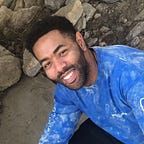We Don't See The Same
As a child, one of my favorite things to do after finishing my school work was to just play games and looking at picture books. A personal favorite of mine was the “Wheres Waldo” series. there was something special about the rush of dopamine that came along with finding the striped gentleman before any of my friends could. Fast forward almost 13 years and I was presented with the color theory of how our color vision is limited. I then thought about how difficult it would have been for me to enjoy something as simple as Wheres Waldo had I been born colorblind. My only strategy to find Waldo was also to just look for that bright red pop and he’ll show up eventually.
Upon looking further into the theory assigned to me, I realized that a lot of the evolving world we live in to is very color-focused. From knowing how to match your style of clothing, to knowing which level of a traffic light is telling you to go. Color is imperative to us as a society and it puts someone who is colorblind at a disadvantage when it comes to interpreting data. To show this I wanted to create a way for those who can see the full-color spectrum to understand how fortunate they are.
Brainstorming and Prototyping
First I started out with a small brainstorm session that could narrow down somethings that are very difficult to do without the luxury of seeing color. I really wanted to stick with the idea of creating some sort of “simple” game and then making it borderline impossible just by changing the way we see it.
To do this I knew I would need a simple color-based game (I have chosen Wheres Waldo)and then a way to have someone play this game as if they were colorblind
Bringing it to Life
I then gathered and altered prototypes of a wheres waldo game. some of these were in full color, creating some sort of control, while other versions of the Wheres Waldo were put through a filter to resemble Deuteranopia Colorblindness. Just by looking at this image above, would understand how someone who is colorblind would struggle with this for hours on end without ever having a hope of finding Waldo.
Testing it out
Finally, I moved on to my interviews and testing to see if it was just me or if this wheres waldo is actually impossible. I tested 3 people to find conclusive information.
- My Friend, Eliot age 20, is a college student from UMKC and was the first person I had test my theory. as I showed him the normal wheres waldos, we flew through them with ease, and was very confident in his ability. This however was completely flipped around when he was shown the filter images. He managed to complete a simple one with the filter, but as they increased in difficulty, we gave up on the rest.
- My Girlfriend, Abby, age 19, is a College student at Florida Southern University was the next person to attempt the Wheres Waldo Gauntlet. She admitted to never being all that great at wheres waldo but showed some promise in the early images with no filter. Upon being shown the filtered images, she said she was developing a headache as the tests went on because of how all the colors mushed together in the image.
- My Sister, Taylor, age 26, who works at Barnes Jewish Hospital was the last person I had test my theory. They really flew through the first wheres waldo images but much like Eliot’s tests, her confidence fleeted she was shown the colorblind images and the background and foreground images all mushed together.
From all of these interviews and tests, we can gather that not seeing the full visible light spectrum can make life very difficult. it requires you to find new ways to solve problems. as I conducted this interview, all of the interviewees said they had to stop relying on the idea of color to find waldo and rather use patterns, textures, and changed in value to find him.
Final thoughts
This research and testing phase of this theory has opened my eyes to things I had never thought about before. As designers, we are problem solvers. we strive to make lives easier for people by creating solutions to everyday problems. This being said, when you design without thinking about those who will be utilizing your design and the obstacles they may already face, you are doing them a disservice. Going forward in the future I will be focusing a lot more on how to make my designs practical for those who may not see the exact same as I do. Whether this is through value, texture, or patterns, I will strive to create designs that can be used by all.
